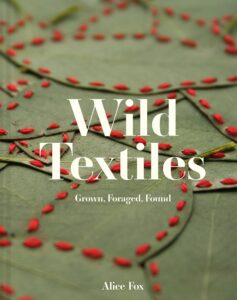SDA Book Club: “Wild Textiles” reviewed by Faith Hagenhofer
January 2, 2024
Wild Textiles: Grown, Foraged, Found by Alice Fox

You would be forgiven in assuming Wild Textiles to be a “how to/field guide,” were you simply perusing. It is both more and less than that. Minimal instruction or directions are given, with the exception of a lengthy discussion on nettles. Wild Textiles is, however, a powerful invitation to the use of sustainable vegetable materials in the creation of art, and a logical outgrowth of Alice Fox’s previous writings. Fox’s quote of author Robin Kimmerer’s words early on form an ideal lens through which to experience the entirety of the book: “One of our responsibilities as human people is to find ways to enter into reciprocity with the more-than-human world. We can do it through gratitude, through ceremony, through land stewardship, science, art, and in everyday acts of practical reverence.”
Simply arranged by the topics in the subtitle (growing, foraging and finding) Alice Fox has presented a clear and generous explication of her place-honoring practice, while also showing the work of a few others that resonate. For example, the single page on the use of a commons was just a peek into this idea, and I wished for more. The copious photographs in Wild Textiles are split into those within a context—landscape, table setting, handheld—and those that are given a white background, so that the focus is entirely on the object or material Fox wants a reader/viewer to carefully look at.
The many intimate objects pictured throughout leads to a feeling of survey over depth, which is very exciting. A nudge to grow a garden features only flax and nettles (I try to keep nettles OUT of my garden, but someone in a different climate could find them exciting). The foraging section is more expansive, with many vegetational fibers considered; that said, a reader is subtly coaxed into looking around. Fox’s list of “useful plants” is just a suggestion, not intended to be exhaustive. Maybe I’ll try some iris leaves, various shrub whips, or some of the new alder growth that are in my environs.
Some of the small images almost seem to be three dimensional sketches, studies for later work. The possibilities! There is a two page spread of nine 2 x 2 inches (5 x 5cm) woven fibers made from cordage in nettle flax/linen, sweetcorn husk, newspaper, cabbage palm, dandelion stems, spun only linen and spun nettle. It is the kind of sampler one could go to, and thus be part of the toolbox.
While I saw no tie to conceptuality in the works pictured, no titles that offer another layer of artist intent or meaning to the objects, I have come to think the entire book is a conceptual exercise, and it feels meant for fellow textile enthusiasts, who are by and large materials-driven; meant to intrigue; meant to excite; meant to further one’s commitment to using materials that have very low environmental impact; meant to draw one to all the handwork that might result.
–Faith Hagenhofer
- Publisher: Batsford (buy it here)
- Date: September 2022
- ISBN: 9781849947879
If you’ve read this book, leave a comment and let us know what you think!
Do you have a recommendation for a recent fiber-related book you think should be included in SDA’s Book Club? Email SDA’s Managing Editor, Lauren Sinner, to let her know!




